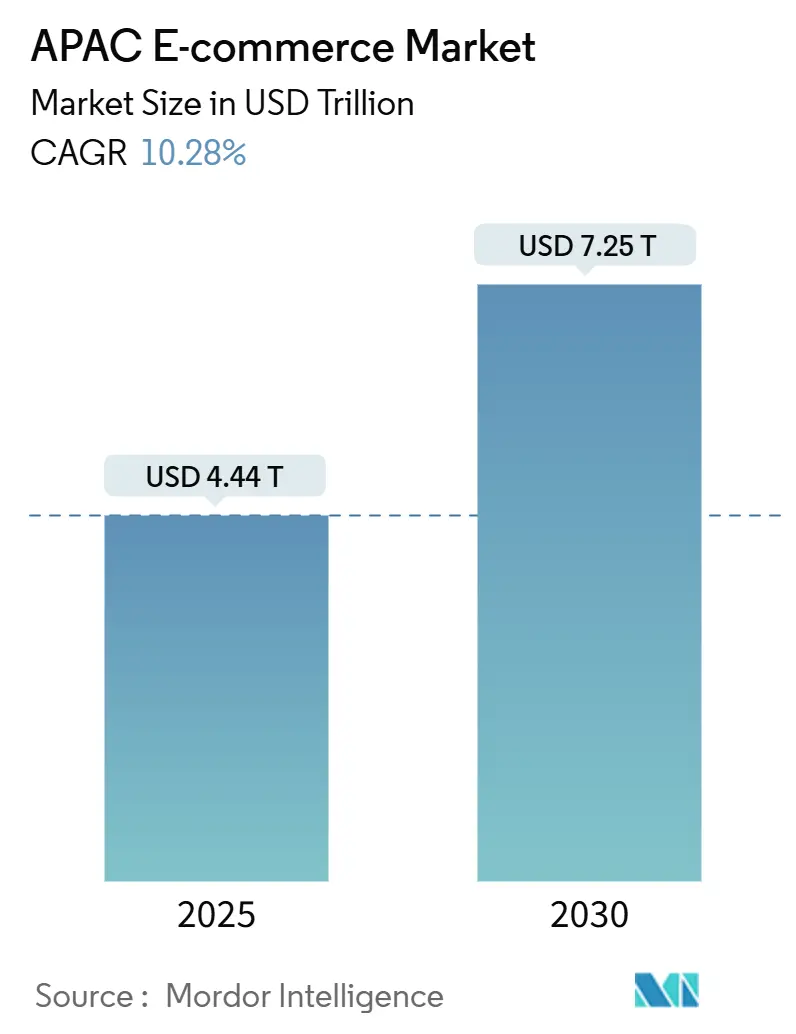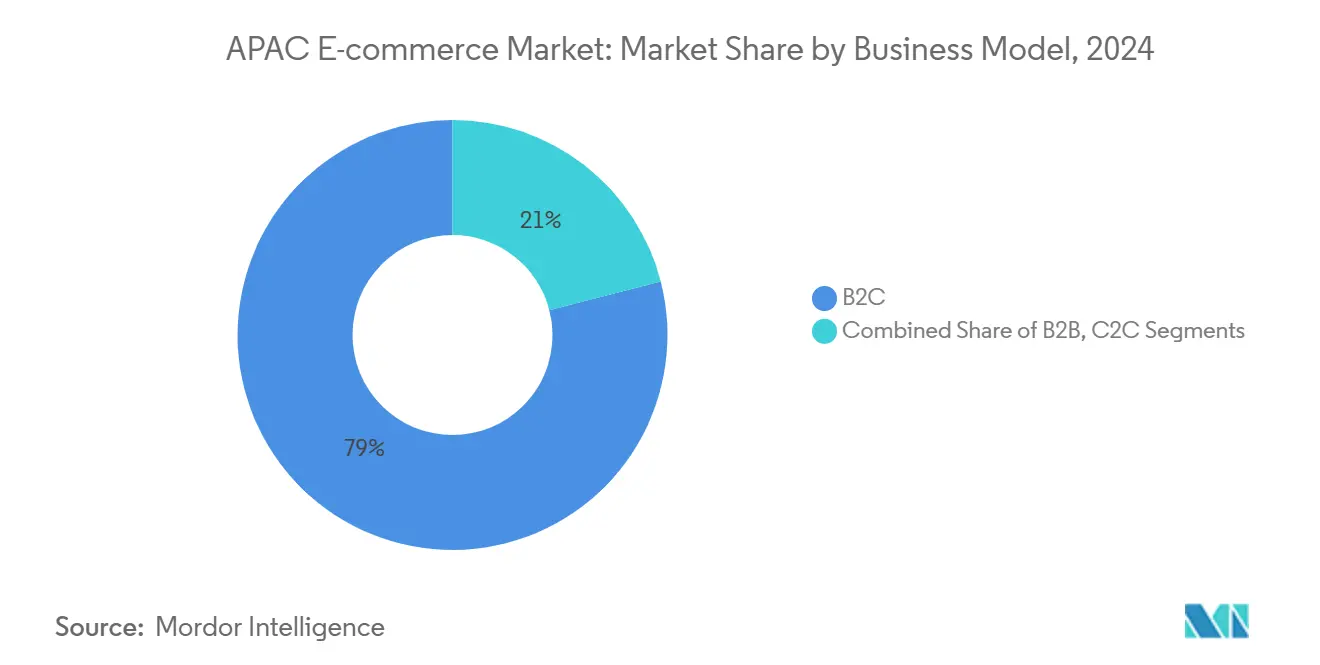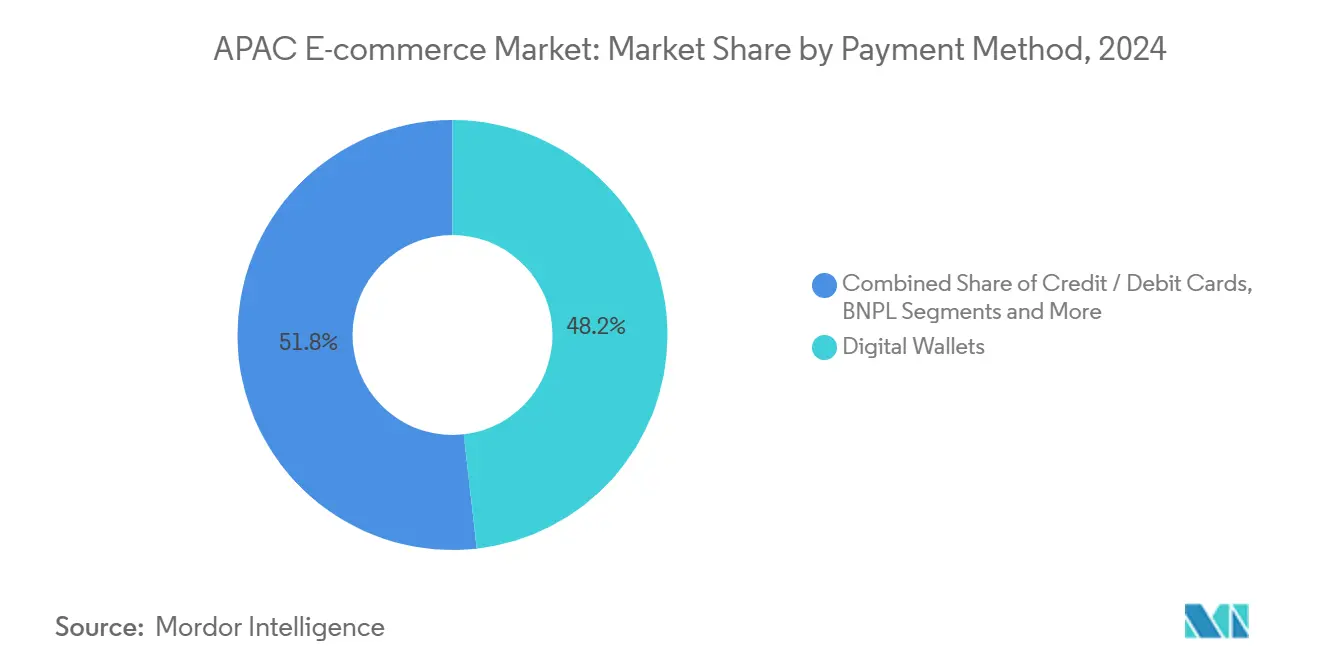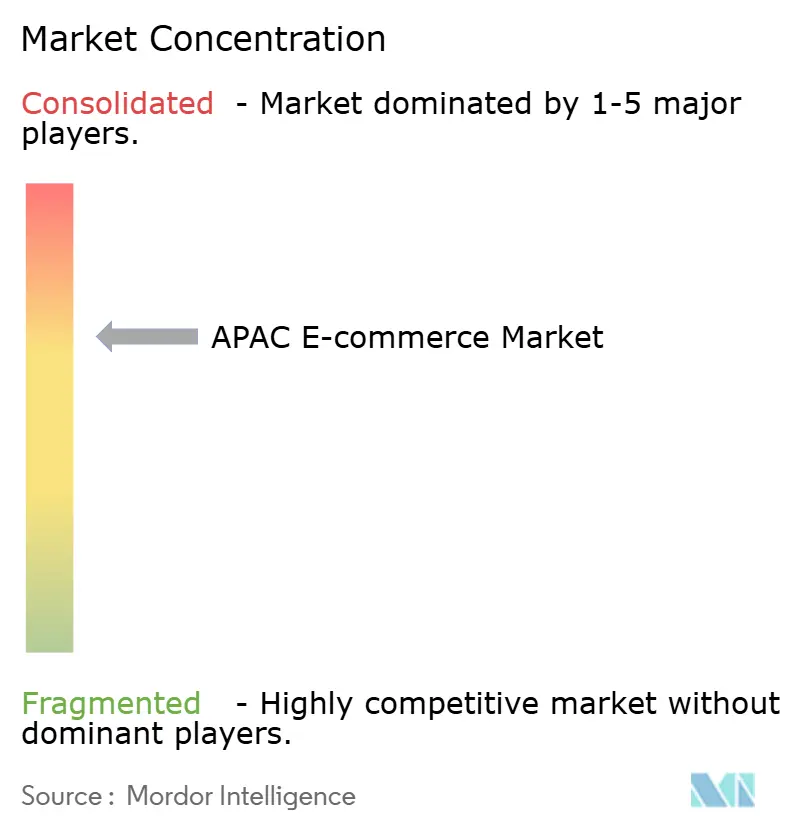
APAC E-commerce Market Analysis by Mordor Intelligence
The APAC e-commerce market is valued at USD 4.44 trillion in 2025 and is projected to expand to USD 7.25 trillion by 2030, reflecting a forecast compound annual growth rate (CAGR) of 10.28%. Growth is underpinned by mobile-first retail habits, rapid 5G roll-outs, and government programmes that bring millions of first-time shoppers online. As disposable incomes climb, premium categories such as beauty and consumer electronics register higher average basket sizes, while aggressive fulfilment investments compress delivery lead times in megacities and remotest archipelagos alike. Cross-border sales accelerate on the back of regional trade pacts that harmonise customs processes and stimulate digital wallet interoperability, even as platforms navigate widening ESG cost obligations and rising data-privacy scrutiny. Competition consequently shifts toward ecosystem leadership, with super-apps leveraging payments, entertainment, and finance to deepen user lock-in and defend margins.
Key Report Takeaways
- By business model, the B2C segment led with 79% revenue share in 2024, while C2C is set to advance at a 16.4% CAGR through 2030.
- By device, mobile transactions commanded 64% of the APAC e-commerce market size in 2024 and are forecast to climb at a 14.2% CAGR to 2030.
- By payment method, digital wallets held a 48.2% share of the APAC e-commerce market size in 2024; Buy Now Pay Later (BNPL) records the highest projected CAGR at 24.2% through 2030.
- By product category, fashion and apparel accounted for 24.7% of the APAC e-commerce market share in 2024, whereas beauty and personal care is growing fastest at 15.2% CAGR to 2030.
- By geography, China retained 29.3% of regional sales in 2024, while the Philippines is on course for the swiftest expansion at an 18.2% CAGR between 2025 and 2030.
APAC E-commerce Market Trends and Insights
Drivers Impact Analysis
| Driver | (~) % Impact on CAGR Forecast | Geographic Relevance | Impact Timeline |
|---|---|---|---|
| Growing disposable income of consumers | 2.6% | China, India, Southeast Asia | Long term (≥ 4 years) |
| Extensive internet accessibility | 2.1% | APAC-wide, with significant impact in rural areas | Medium term (2-4 years) |
| Rapid adoption of m-commerce and super-apps | 1.9% | China, Southeast Asia, India | Medium term (2-4 years) |
| Govt-led cross-border e-commerce pacts | 1.5% | ASEAN, China, Japan, South Korea | Long term (≥ 4 years) |
| Social-commerce and live-stream shopping boom | 1.2% | China, Thailand, Vietnam, Indonesia | Short term (≤ 2 years) |
| AI-driven hyper-local fulfillment hubs | 1.0% | Singapore, China, Japan, South Korea | Medium term (2-4 years) |
| Source: Mordor Intelligence | |||
Growing Disposable Income of Consumers
Rising middle-class prosperity is lifting discretionary budgets and accelerating online spending. China’s per-capita disposable income hit CNY 43,760 (USD 6,170) in 2024, enabling households to trade up to premium labels through digital storefronts. India’s expanding middle class is on track to account for 80% of national consumption by 2030, broadening addressable demand beyond metro cities. Each 1% bump in Southeast Asian household income translates into a roughly 1.5% uptick in online purchase frequency. [2]United Nations Conference on Trade and Development, “Digital Trade Fuels Asia-Pacific’s Growth, but Progress is Uneven,” unctad.org Tier-2 and tier-3 locations feel the effect most strongly, as lower living costs leave more discretionary cash for e-commerce baskets. Platforms that localise assortments and vernacular marketing are therefore capturing fresh cohorts of previously offline shoppers.
Extensive Internet Accessibility
The region adds millions of first-time users annually as infrastructure projects narrow the urban–rural divide. Mobile subscribers generated 40% of global net additions from 2025 to 2030, according to GSMA. [1]GSMA, “The Mobile Economy 2025,” gsma.com Rural China achieved 66.6% internet penetration by late 2023, mirroring connectivity drives in India and Indonesia that link remote villages via national fibre corridors. Improved access sparks quicker e-commerce uptake among small businesses as well, with digital storefronts helping exporters bypass 47 historic trade barriers. Government inclusivity programmes consequently foster a more balanced growth profile between metropolitan and hinterland demand pools.
Rapid Adoption of M-commerce and Super-apps
Super-app ecosystems place messaging, ride-hailing, payments and shopping within a single sign-on, lowering transaction friction. Mobile devices already deliver 61.35% of regional web traffic, peaking at 79.1% in Indonesia and 74.2% in Thailand. Video-rich content streams join embedded finance services such as BNPL, turning smartphones into primary retail gateways for the Gen Z and millennial segments who favour instalment plans for 76% of purchases. [3]Visa, “Inside the Minds of Buy Now, Pay Later Shoppers in Asia Pacific,” visa.com.sg As 5G penetration surpasses the 1 billion-connection mark by 2025, latency-free interactive formats further normalise mobile-only checkout behaviour.
Govt-led Cross-border E-commerce Pacts
Regulatory cooperation accelerates trade flows and reduces compliance friction. The ASEAN Agreement on Electronic Commerce reached full implementation in 2024, offering a common legal baseline. Vietnam’s January 2025 cross-border decree and Indonesia’s MOTR 31/2023 similarly clarify operating rules for overseas sellers. [4]OpenGov Asia, “New Regulations Strengthen Cross-Border E-Commerce,” opengovasia.com RCEP’s 15 members now benefit from lower tariffs and standardised customs data, while central-bank MoUs link national e-wallet networks to create instant regional settlement. Collectively, these measures enlarge the addressable customer base for merchants and logistics providers alike.
Restraints Impact Analysis
| Restraint | (~) % Impact on CAGR Forecast | Geographic Relevance | Impact Timeline |
|---|---|---|---|
| Security and privacy concerns | -1.5% | APAC-wide, particularly Japan, South Korea, Australia | Medium term (2-4 years) |
| Fragmented last-mile logistics | -1.2% | Indonesia, Philippines, Vietnam, India | Short term (≤ 2 years) |
| Cross-border tax complexity | -1.0% | APAC-wide, particularly affecting cross-border sellers | Medium term (2-4 years) |
| Rising ESG-compliance platform costs | -0.8% | China, Japan, Singapore, Australia | Long term (≥ 4 years) |
| Source: Mordor Intelligence | |||
Security and Privacy Concerns
Data-management rules tighten across multiple jurisdictions. China’s Personal Information Protection Law, effective in 2024, permits fines of up to 5% of annual turnover for breaches. Divergent legal frameworks force platforms to duplicate compliance toolkits by market, while 18% of online shoppers still abandon carts over payment-security doubts. Cross-border sellers adopt advanced fraud-filtering engines to maintain trust without adding checkout friction.
Fragmented Last-mile Logistics
Geography hampers cost-effective delivery, especially across Indonesia’s 17,000+ islands. Last-mile fees absorb up to 53% of total logistics spend in the Philippines and Vietnam, and urban congestion inflates cycle times in Manila and Jakarta by 30-45% versus global peers. Scale advantages allow larger platforms to operate proprietary courier fleets, squeezing smaller entrants on both cost and service-level metrics.
Segment Analysis
By Business Model: Social Marketplaces Reconfigure Commerce
The B2C format dominated the APAC e-commerce market in 2024, securing 79% revenue share as established platforms widened assortment breadth and fulfilled at a nationwide scale. Yet the C2C surge—posting 16.4% CAGR to 2030—signals a structural shift toward peer-led retail communities. Social marketplaces translate previously informal sales of second-hand goods and artisan creations into trackable, tax-compliant transactions. For incumbents, the trend necessitates integrating social-selling toolkits to protect audience attention spans and basket value. The APAC e-commerce market size for C2C-led activity is forecast to multiply alongside smartphone penetration in lower-income clusters, where micro-entrepreneurship offers supplemental earnings without formal storefront fees.
Meanwhile, B2B exchanges migrate procurement to cloud-native workflows. With a forecast outlay of USD 36 trillion by 2026, these portals digitise credit vetting and customs documentation, compressing transaction cycles for regional exporters. RCEP’s tariff reductions amplify addressable spend, enabling small factories in Vietnam or Thailand to court buyers in Japan within a digitally managed trust framework. Hybrid models increasingly emerge, as large retail platforms open wholesale channels to monetise scale logistics.

Note: Segment shares of all individual segments available upon report purchase
By Device Type: Mobility Shapes User Journeys
Handsets accounted for 64% of 2024 transactions, cementing a mobile-centric design philosophy that prioritises one-hand navigation, vertical video, and biometric checkout. Emerging markets effectively skipped the desktop era; for many rural Indonesians or Thais, a smartphone is the sole internet gateway. With 5G coverage spreading, high-definition livestreaming becomes mainstream, spurring incremental sales conversions. The APAC e-commerce market size linked to mobile is forecast to outstrip overall growth at a 14.2% CAGR, pushing developers to build native super-app modules rather than responsive desktop clones.
Laptops and desktops retain relevance for considered purchases—enterprise software licences or bulk industrial supplies—where side-by-side comparison and longer dwell times outweigh on-the-go convenience. Voice interfaces and connected-TV shopping remain nascent but gain traction as smart-home ecosystems proliferate, hinting at a future omnichannel mesh where transaction context rather than device dictates checkout flow.
By Payment Method: Digital Wallets Anchor Financial Inclusion
Digital wallets captured 48.2% of 2024 online transaction value, reflecting deep consumer penetration of Alipay, WeChat Pay, and GCash, each bundling transfer, savings, and micro-credit within a single app. This model leapfrogs legacy card rails in economies where formal banking outreach is limited. The APAC e-commerce market size routed through wallet ecosystems expands as merchant acceptance broadens beyond urban centres.
BNPL, scaling at a 24.2% CAGR through 2030, supplies credit access to thin-file consumers wary of revolving debt. Australia and New Zealand already see BNPL claiming 21.5% and 11.9% of e-commerce payments, respectively, while India’s UPI network experiments with pay-later overlays. Traditional cards still dominate in mature economies such as Japan, where loyalty points and chargeback frameworks reinforce entrenched habits. Cash-on-delivery shrinks yet persists in niche segments that prize physical settlement.

Note: Segment shares of all individual segments available upon report purchase
By B2C Product Category: Beauty Accelerates on Social Proof
Fashion and apparel retained the largest slice of APAC e-commerce market share at 24.7% in 2024, capitalising on high purchase frequency and visual merchandising compatibility. Virtual try-on augments sizing confidence, and influencer-led unboxings fuel impulse wardrobes. The segment continues to act as a gateway for customer acquisition before cross-selling into adjacent verticals.
Beauty and personal care emerges as the speedster with 15.2% CAGR to 2030, propelled by livestream tutorials that compress discovery and checkout into a single swipe. The APAC e-commerce market size for beauty gains incremental lift from K-beauty and J-beauty exports, while halal-certified skincare caters to Southeast Asia’s sizeable Muslim demographic. Electronics command premium ticket values, groceries benefit from quick commerce networks, and furniture sees meaningful adoption thanks to AR visualisation solving spatial uncertainty.
Geography Analysis
China preserved 29.3% of regional turnover in 2024, yet its CAGR moderates to 9.9% as urban penetration saturates and antitrust oversight intensifies. Ecosystem competition displaces price wars; Alibaba and JD.com bundle cloud, fintech, and media to widen entry barriers. Alternative payment instruments dominated 65.9% of Chinese online spend in 2023, underscoring the continuing wallet-first paradigm. Cross-border initiatives under Beijing’s 14th Five-Year Plan extend export support to SMEs, anchoring China’s role as both buyer and seller within the APAC e-commerce market. frictionless
The Philippines exhibits textbook leapfrog dynamics, charting an 18.2% CAGR for 2025-2030 on top of a USD 17 billion 2021 baseline. Smartphone penetration of 74.1% and daily social-media engagement exceeding 10 hours enable frictionless buyer journeys despite patchy logistics. Digital payments accounted for 42.1% of retail settlements in 2022, signalling accelerating financial inclusion. Government roadmaps target full-economy digitalisation, ensuring sustained upside.
India advances toward a USD 200 billion market by 2026, buoyed by the Unified Payments Interface processing 8.7 billion monthly transfers by early 2025. Tier-2 and tier-3 hinterlands now contribute a rising share of GMV as logistics corridors extend. Domestic champions like Flipkart and Reliance confront Amazon’s localisation drive, competing on vernacular interfaces and same-day grocery coverage. Japan and South Korea, while mature, sustain high average order values and set service benchmarks—next-day delivery is table-stakes and consumer expectations steer platform investment in micro-fulfilment robotics. Indonesia’s archipelago hits USD 120 billion by 2025, leveraging social-commerce workarounds to surmount geography-induced shipping hurdles.
Competitive Landscape
Regional concentration varies sharply. China skews toward oligopoly, with two conglomerates orchestrating multi-service ecosystems that erect scale moats. In ASEAN, however, competitive intensity remains elevated as country-specific champions vie with transnational entrants. Platforms diversify into embedded finance—Sea Limited’s Shopee Bank in Malaysia or Lazada’s buy-now-pay-later rails—to amplify stickiness and monetise broader value pools.
White-space exists at the content-commerce nexus. TikTok Shop leveraged native video feeds to seize 2.6% of APAC GMV within eighteen months, validating entertainment-led conversion. Legacy marketplaces counter by integrating short-video modules and creator-affiliation schemes. Artificial intelligence amplifies differentiation: Rakuten’s collaboration with Microsoft to personalise recommendations targets a 30% uplift in conversion efficiency. Data-science muscle also underpins predictive fulfilment networks that shave last-mile costs and unlock rural addressable markets.
Regulatory scrutiny of dominance encourages strategic alliances and minority stake swaps to pre-empt antitrust action. Alibaba’s USD 15 billion infusion into Cainiao underscores logistics as the next theatre of competition—speed and reliability now trump headline discounts. Meanwhile, ESG imperatives force incumbents to retrofit operations toward low-carbon models, a shift smaller players exploit via agile partnerships with electric-fleet start-ups. Net result: rivalry migrates from simple price wars to end-to-end solution craftsmanship.
APAC E-commerce Industry Leaders
Alibaba Group Holding Ltd.
Amazon.com Inc.
JD.com Inc.
Rakuten Group Inc.
Sea Ltd. (Shopee)
- *Disclaimer: Major Players sorted in no particular order

Recent Industry Developments
- April 2025: JD.com debuted a cross-border marketplace in Thailand, pairing RCEP tariff relief with local-wallet acceptance to shorten the route-to-market for Chinese brands.
- March 2025: Sea Limited’s Shopee won a Malaysian digital-bank licence, enabling deposit and lending services that weave tighter super-app engagement loops.
- February 2025: Rakuten partnered with Microsoft to deploy AI-driven personalisation, targeting 30% higher conversion through real-time relevance algorithms.
- January 2025: Alibaba Group committed USD 15 billion to expand Cainiao’s automated fulfilment hubs across Southeast Asia, aiming to guarantee one-day delivery in tier-1 cities.
Research Methodology Framework and Report Scope
Market Definitions and Key Coverage
Our study defines the Asia-Pacific e-commerce market as every business-to-consumer, business-to-business, and consumer-to-consumer product or service transaction that is initiated over the public internet and settled through an electronic payment, regardless of fulfilment mode or device.
Scope Exclusions: Pure digital media downloads, ride-hailing fares, and enterprise EDI flows are not counted.
Segmentation Overview
- By Business Model
- B2C
- B2B
- C2C
- By Device Type
- Smartphone / Mobile
- Desktop and Laptop
- Other Device Types
- By Payment Method
- Credit / Debit Cards
- Digital Wallets
- BNPL
- Other Payment Method
- By B2C Product Category
- Beauty and Personal Care
- Consumer Electronics
- Fashion and Apparel
- Food and Beverages
- Furniture and Home
- Toys, DIY and Media
- Other Product Categories
- By Country
- China
- India
- Japan
- South Korea
- South East Asia
- Australia and New Zealand
- Rest of Asia-Pacific
Detailed Research Methodology and Data Validation
Primary Research
Mordor analysts interview marketplace category managers, third-party logistics executives, payment-gateway product heads, and SME exporters across China, India, Japan, South Korea, and the ASEAN corridor to validate secondary findings, plug data gaps, and refine elasticity assumptions.
Desk Research
We build the foundation with open datasets from agencies such as UNCTAD, the World Bank, GSMA, national statistics offices (for example, China's NBS and India's RBI digital-payment dashboard), and regional trade associations. Company filings, investor decks, and reputable business press gathered through Dow Jones Factiva and D&B Hoovers complement macro sources and give us merchant-level clues on average selling price (ASP) shifts.
Shipping manifests (Volza), patent filings queried on Questel, and customs duty receipts help us cross-check cross-border volumes, while academic journals clarify consumer behavior pivots after policy moves such as India's ONDC rollout. The list above is illustrative rather than exhaustive.
Market-Sizing & Forecasting
A top-down construct starts with official retail sales and digital-payment penetration, which are then adjusted for online share, basket value, and return rates. Supplier roll-ups of leading platforms' GMV and sampled ASP × parcel counts serve as bottom-up checks that fine-tune totals. Key variables tracked include smartphone penetration, digital-wallet share at checkout, parcel volume per capita, discretionary-spend elasticity, and average cross-border duty per order.
We project the market with a multivariate regression blended with scenario analysis, anchoring coefficients on historical correlations and forward opinions gathered in primary calls. Where platform data are partial, interpolation is guided by regional parcel scans and currency-adjusted ASP trends.
Data Validation & Update Cycle
Outputs pass multi-step peer review, variance thresholds, and anomaly flags before sign-off. Reports refresh annually, and we trigger interim updates when material policy, FX, or supply-chain shocks emerge. A last-mile analyst sweep ensures clients always receive the latest view.
Why Mordor's APAC E-Commerce Baseline Commands Reliability
Published estimates often diverge because firms choose different scopes, currencies, and refresh rhythms.
Key gap drivers include whether services like digital media are added, if B2B flows are omitted, the currency conversion date, and the cadence at which models absorb new GMV disclosures. Mordor's disciplined variable selection, annual refresh, and dual-path validation keep our figure centered and transparent.
Benchmark comparison
| Market Size | Anonymized source | Primary gap driver |
|---|---|---|
| USD 4.44 trillion (2025) | Mordor Intelligence | |
| USD 10.70 trillion (2024) | Global Consultancy A | Bundles digital media, travel, and ticketing; limited merchant verification |
| USD 2.90 trillion (2024) | Regional Consultancy B | Counts B2C GMV only, excluding B2B and recommerce flows |
| USD 2.98 trillion (2022) | Trade Journal C | Relies on pre-pandemic baseline and outdated FX rates; refresh every three years |
Differences show that scope breadth and data freshness, rather than complex math, explain most spread. By aligning inputs to clear transaction tests and refreshing yearly, Mordor Intelligence delivers a balanced, decision-ready baseline that clients can trace and replicate.
Key Questions Answered in the Report
What is the current value of the APAC e-commerce market?
It stands at USD 4.44 trillion in 2025 and is projected to reach USD 7.25 trillion by 2030.
Which business model leads regional online sales?
The B2C model commands 79% of revenues, although C2C marketplaces are growing faster at a 16.4% CAGR.
How dominant are mobile purchases in APAC?
Mobile transactions accounted for 64% of all online orders in 2024 and are expanding at a 14.2% CAGR.
Why are digital wallets so influential in the region?
Wallets captured 48.2% of transaction value in 2024 because they combine payments, savings and micro-credit, serving users without traditional bank accounts.
Which product category is growing fastest online?
Beauty and personal care leads with a 15.2% CAGR, propelled by livestream tutorials and influencer-led social commerce.
What logistical innovation is shaping fulfilment strategies?
AI-powered micro-fulfilment hubs are reducing delivery distances by up to 65%, enabling same-day or even sub-hour shipping in dense urban markets.



